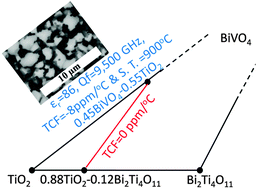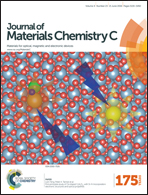Novel temperature stable high-εr microwave dielectrics in the Bi2O3–TiO2–V2O5 system
Abstract
In the present work, a series of low temperature firing (1 − x)BiVO4–xTiO2 (x = 0.4, 0.50, 0.55 and 0.60) microwave dielectric ceramics was prepared using traditional solid state reaction method. From back-scattered electron images (BEI), X-ray diffraction (XRD) and energy dispersive analysis (EDS), there was negligible reaction between BiVO4 and TiO2 at the optimal sintering temperature ∼900 °C. As x increased from 0.4 to 0.60, permittivity (εr) increased from 81.8 to 87.7, quality factor value (Qf) decreased from 12 290 to 8240 GHz and temperature coefficient (TCF) shifted from −121 to +46 ppm per °C. Temperature stable microwave dielectric ceramic was obtained in 0.45BiVO4–0.55TiO2 composition sintered at 900 °C with a εr ∼ 86, a Qf ∼ 9500 GHz and a TCF ∼ −8 ppm per °C. Far-infrared reflectivity fitting indicated that stretching of Bi–O and Ti–O bonds in this system dominated dielectric polarization. This series of ceramics are promising not only for low temperature co-fired ceramic (LTCC) technology but also as substrates for physically and electrically small dielectrically loaded micro-strip patch antennas.


 Please wait while we load your content...
Please wait while we load your content...